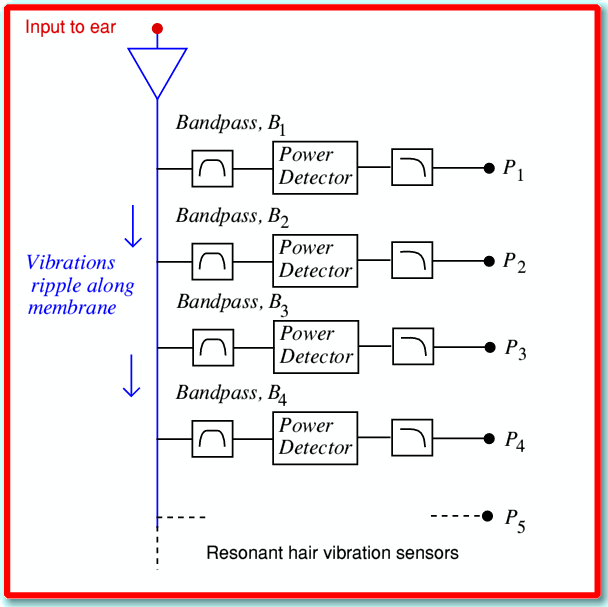Physical Model of Human Hearing
Here we are primarily concerned with the behaviour of the human cochlea.
Sound vibrations enter the ear and set up ripples that run along a membrane in the inner ear. There are bunches or bundles of tiny hairs on the surface of this membrane. The vibrations tend to shake the hair bundles, and each bundle will tend to resonate to a particular band of frequencies. Near the input end of the membrane the hair bundles are tiny, and so tend to resonate at high frequencies. However the hairs vary in size along the membrane, so at each location they tend to resonate to a different frequency.
The system can be thought of as a bank or array of narrowband filters that respond to various frequencies. The brain then detects the power levels of the vibrations of all the hair bunches and uses this to work out which frequencies are present in the sound.
The traditional view is to regard each of these resonant sensors as simple bandpass filter, and assign a series of frequencies and bandwidths to these filters. The resulting system is analogous to the Fourier Transform which analyses signals in terms of how much power is present at any given frequency. During the last decade experiments have lead to changes in how this system is thought to work. Physiologists now regard the resonant hair bundles as active, non-linear sensors whose effective bandwidth and sensitivity vary in response to the incoming vibrations they experience. As the level of vibrations is increased, the hair bundles react by lowering their sensitivity and widening the band of frequencies to which they respond. As a result, the response of the ear and brain to sounds is much more complex than the traditional model showed. The nonlinearity of the response is a key to understanding many of the surprising properties of human hearing.
To completely model human hearing we would have to develop an analysis that dealt with many aspects of this complicated nonlinear system. However for the results presented in the main ‘Ringing in the Ears’ webpages we can concentrate on the behaviour of the non-linear resonators that act as active bandpass sensors in the above arrangement.

